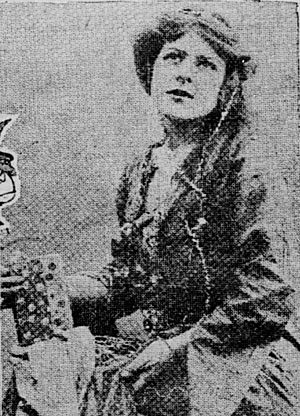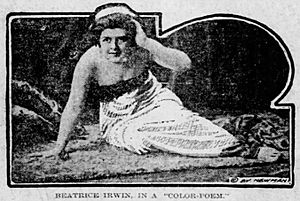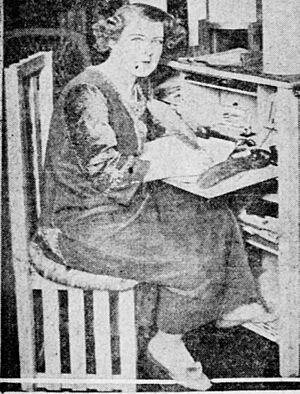Beatrice Irwin facts for kids
Quick facts for kids
Beatrice Irwin
|
|
|---|---|
 |
|
| Born |
Alice Beatrice Simpson
July 16, 1877 Dagshai
|
| Died | March 20, 1953 (aged 75) |
| Occupation | Actress, poet, designer and Baháʼí advocate |
Beatrice Irwin (born July 16, 1877, in Dagshai, India; died March 20, 1953, in San Diego, California) was a talented woman who worked as an actress, poet, and designer. She was also a strong supporter of the Baháʼí Faith. Born Alice Beatrice Simpson, she later chose Beatrice Irwin as her stage name and eventually used it as her real name.
Beatrice Irwin's life was full of travel and new ideas. She started as an actress, performing in many countries. Later, she became known for her unique work with color and light, even inventing special lighting. She also wrote poetry and became deeply involved in the Baháʼí Faith, a religion that teaches about unity and peace. She spent many years sharing its message around the world.
Contents
Beatrice Irwin's Life Journey
Early Years and Education
Beatrice Irwin was born in India in 1877. Her grandfather, John Hall, was in the British Army. Her mother, Alice, married an Anglican minister named William Simpson. Beatrice was their second daughter.
When Beatrice was a child, her family moved to Scotland and then to England. She attended Cheltenham Ladies' College, a well-known school for girls. She graduated in 1895 and did very well in her exams, earning an "Associate in Arts" title from Oxford University.
While still young, Beatrice met the famous actress Ellen Terry. Terry suggested that Beatrice consider a career in theatre after finishing school. Beatrice's mother and sisters also became interested in mystical groups like the Hermetic Order of the Golden Dawn, but Beatrice chose a different path.
Becoming an Actress
Around 1897, Beatrice began her acting career, using the stage name "Beatrice Irwin." She quickly started performing in plays in England. Her acting took her to many places, including Cape Colony (now part of South Africa), America, and even briefly to Australia and Shanghai.
In 1899, she joined a theatre company from London that toured New York. The company manager was Bram Stoker, famous for writing Dracula. Beatrice received positive reviews for her acting during these tours. She continued to perform in London and New York in popular plays like "The Importance of Being Earnest" and "Mrs Dane's Defence."
In 1902, Beatrice was in another London play called "The New Clown," which also earned her good comments. She then traveled to America for a play called "There's Many a Slip." During this time, news spread that she was engaged to James Francis Harry St Clair-Erskine, the Earl of Rosslyn. This engagement was widely reported in newspapers. However, by early 1903, she ended the engagement and left the theatre company.
After a short break, Beatrice returned to the stage in London in "The Admirable Crichton." She continued acting, but by late 1903 and early 1904, she faced some health issues and had to leave performances.
In 1907, Beatrice joined a theatre group touring Australia. She gave interviews, sharing her love for languages and horse-riding. She also mentioned performing in Shanghai at some point. However, she became ill during the Australian tour and returned to England.
Poetry and the Science of Color
Around 1910, Beatrice started publishing her poetry in America. She also began to combine her artistic talents with a new interest: the intentional use of colored light. She believed that colors could have a powerful effect on people.
She created a unique one-woman performance called "Color Poem." In this show, she used special colored lighting and wore different costumes to represent women from around the world. This pioneering work caught the attention of many, including the famous French sculptor Auguste Rodin, who encouraged her studies in color.
In 1912, Beatrice published her book of poetry, Pagan Trinity. It included sections like "Colour poems" and "Songs of the Elements." She dedicated the book to Auguste Rodin.
Discovering the Baháʼí Faith
Beatrice had some contact with Theosophy (a spiritual movement) before 1910. She then met Inayat Khan, a leader of Sufism (a mystical branch of Islam). Most importantly, she met ʻAbdu'l-Bahá, the leader of the Baháʼí Faith, during his visits to Europe. She felt a strong connection to this new religion.
Beatrice spent six months with ʻAbdu'l-Bahá in Paris, meeting him daily. She was deeply impressed by his wisdom and kindness. She later wrote about how he encouraged spiritual development for everyone, rather than just individual mystical experiences. By 1912, she was considered a Baháʼí.
In 1913, she translated one of ʻAbdu'l-Bahá's talks from French to English on the spot, showing her quick thinking and dedication. She also wrote an article for Occult Review explaining the history and teachings of the Baháʼí Faith. She saw the Baháʼí Movement as a source of spiritual certainty in a world full of different beliefs.
Color Specialist and Baháʼí Advocate
During World War I, Beatrice continued her work. In 1915, she gave demonstrations of her studies on the art and science of color at the Panama-Pacific International Exposition in San Francisco. She also promoted her new book, The New Science of Colour. For her presentations, she won a bronze medal.
Beatrice became known as an "Illuminating Specialist." She even patented a special lighting fixture. She believed that colors could have healing properties and affect people's moods. She debated her ideas with scientists, arguing that different shades of red, green, and blue could be used as sedatives, recuperatives, or stimulants.
Her work on color technology was widely covered in trade journals and newspapers. She was recognized as a member of the Illuminating Engineering Society of North America (IESNA). She even designed lighting for events at famous places like the Ritz-Carlton Ballroom.
In 1919, Beatrice attended the Baháʼí Convention in New York, where the Tablets of the Divine Plan were presented. These were letters from ʻAbdu'l-Bahá encouraging Baháʼís to spread their teachings around the world. Beatrice took this message to heart.
Global Travels and Baháʼí Service
In 1930, Beatrice went on a Baháʼí pilgrimage to Haifa, in what was then Palestine. She visited the Shrine of the Báb and the Baháʼí gardens, which she described as a place of "ineffable calm." She even installed her special "Irwin Colour Filter" lighting system at the Baháʼí Shrines, calling it "The Gate."
After her pilgrimage, she published another book, The Gates of Light, which included pictures of her lighting installations at the Baháʼí Shrines. She wrote about how the Baháʼí Faith connected religion with science and promoted universal tolerance.
Beatrice became a dedicated promoter of the Baháʼí Faith. In the mid-1930s, she joined efforts to spread the religion in Latin America, even though she wasn't fluent in Spanish. She traveled to Mexico in 1937, giving talks and writing articles about her experiences. She also visited Brazil, where she worked as a "good will correspondent," observing the country's peaceful nature.
She continued to give talks and write articles about peace and the Baháʼí teachings. In 1942, she wrote an article called The New Citizenship, where she discussed how citizenship should expand from loyalty to a country to loyalty to all humanity. She believed that the Baháʼí teachings offered a "spiritual democracy" for the world.
Beatrice continued her travels and advocacy throughout the 1940s, giving talks in various cities across the United States. In 1948, she traveled to Tunis, where she held weekly meetings and radio broadcasts, helping to establish a Baháʼí community there.
Later Years and Legacy
In her later years, Beatrice continued to give talks on her travels, her work with color, and the Baháʼí Faith. She shared her experiences and insights with many people.
Beatrice Irwin passed away in San Diego in 1953. Shoghi Effendi, the head of the Baháʼí Faith at the time, sent a telegram expressing sadness at her passing, calling her a "steadfast devoted indefatigable promoter Faith." Her life was a testament to her diverse talents and her deep commitment to promoting unity and understanding in the world.
Images for kids





